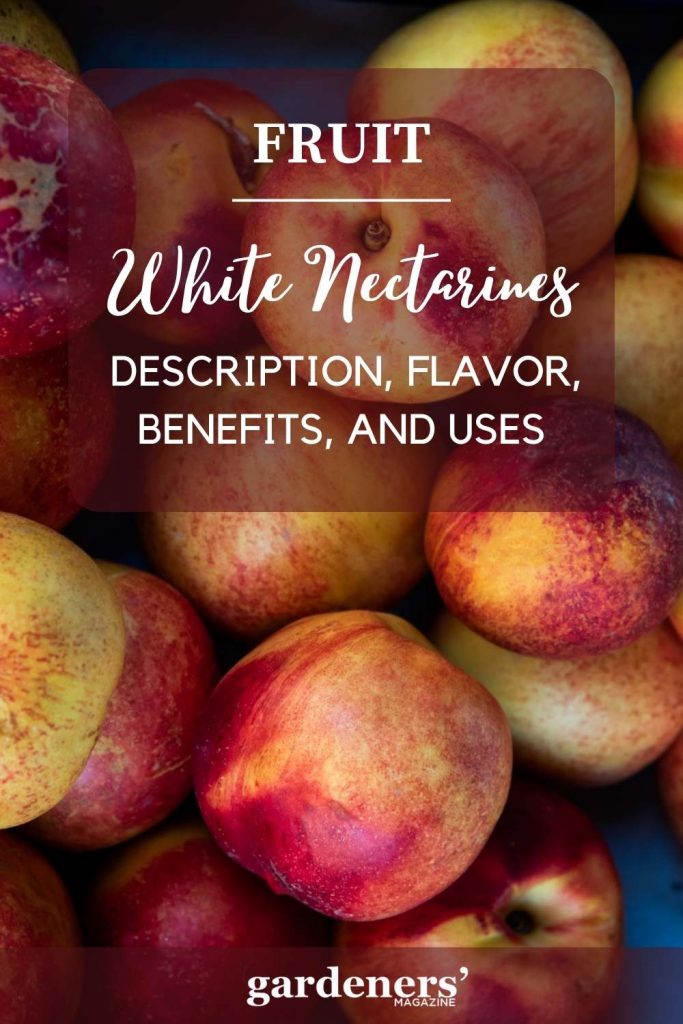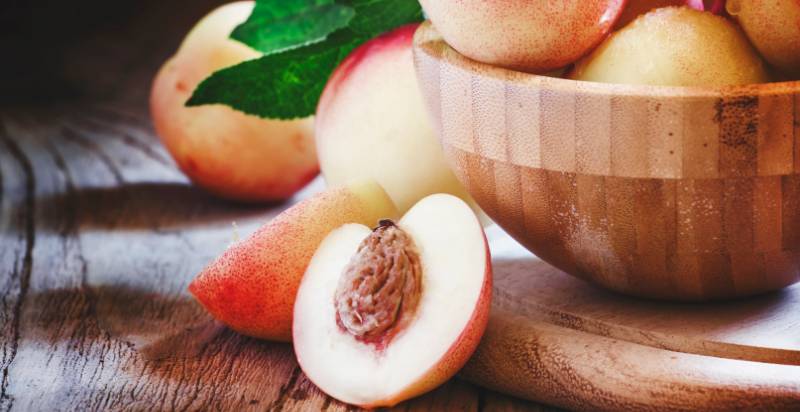White nectarines are a delicious, juicy, and sweet summer fruit. They have a unique flavor that is often described as being both sweet and tart. White nectarines are a variety of the same species as peaches, Prunus persica, with different genetic traits that give them a white-fleshed appearance. They are full of nutrients and antioxidants, making them a great addition to any healthy diet. This article reviews nutrition facts, health benefits, and ways to enjoy white nectarines.
What are White Nectarines?
White nectarines are stone fruit of the same species as peaches, Prunus persica. They have white flesh and smooth, slightly fuzzy skin that may be yellow or orange. The interior of the fruit is usually sweet and juicy with some tartness. White nectarines are thought to be a mutation of yellow peaches and have been grown for centuries in China and other parts of Asia.

History and Origin of White Nectarines?
White nectarines are a relatively recent addition to the world of stone fruit. They originated in China, where records show they have grown since at least the 16th century. White nectarines were believed to be originally bred by crossing yellow peaches and apricots. The resulting genetic mutation created a new variety of fruit with white flesh instead of yellow.
White nectarines were first introduced to Europe in the late 19th century, and commercial production began shortly after. They have become increasingly popular over the years, as their mild and sweet flavor has made them a favorite snack among many fruit lovers. Today, white nectarines are grown worldwide and are available year-round in many supermarkets. Their popularity continues to grow as more and more people discover their sweet taste and versatility in cooking and baking.
Description of the White Nectarines
White nectarines are a stone fruit with an oval shape and white to pale yellow skin. They have a mildly sweet flavor with a hint of tartness, making them perfect for eating fresh or baking. The flesh of the white nectarine is firm and juicy and usually around 7 cm in diameter.
When ripe, they should be slightly soft and have a fragrant aroma. They can also be used in jams and jellies, added to salads, or grilled for an interesting flavor. White nectarines are packed with vitamins and antioxidants, making them a nutritious addition to any diet.
Flavor Profile of the White Nectarines
They are sweet and tart, with juicy flesh compared to other varieties. The texture of the white nectarine is quite firm but still has a bit of crunch when bitten into. The skin is thin and smooth and can be eaten, unlike other nectarine varieties, which have thick or fuzzy skins. White nectarines pair well with complementary flavors such as coconut, lime, and ginger for a unique summer dessert. They also make great additions to salads or are eaten with a sprinkle of sea salt. Additionally, white nectarines, including pies, cobblers, tarts, and more, can be used in baking.
Health Benefits of White Nectarines
White nectarines are a great source of nutrition, offering various health benefits. They provide dietary fiber and important vitamins like vitamins A, C, folate, and potassium. Eating white nectarines can help with weight management as they are low in calories but high in nutrients. These fruits also contain antioxidants that protect against cell damage caused by free radicals, which can help promote a healthy immune system.
White nectarines are also known to have anti-inflammatory properties, helping to reduce the risk of certain chronic health conditions such as heart disease and type 2 diabetes. Additionally, white nectarines can aid digestion because they contain prebiotic fiber that helps feed beneficial bacteria in your gut. Eating white nectarines can also help promote healthy skin due to their high vitamin A levels, which helps reduce the risk of acne.
Cultivation of the White Nectarines
White nectarines require well-drained, fertile soils and a deep summer chill (at least 350 hours below 7°C). They need full sun with the roots in moist soil for optimal growth and fruiting. Pruning should be done every year to remove dead or diseased branches. Make sure there is adequate spacing between trees for good air circulation. Fertilizer should be applied annually in the spring with a balanced fertilizer. If necessary, a light mulch can be added to help retain moisture in the soil and reduce weeds. Summer irrigation may be necessary for the optimal production of fruits. Be sure to monitor water needs and adjust as needed.
Fungal diseases like brown rot and powdery mildew can be problematic in wetter climates. To reduce disease pressure, proper pruning and spacing of trees and the application of fungicides or other organic treatments before an infection occurs. Additionally, fruit should be harvested and stored properly to reduce the risk of fungal growth on the fruits.
White nectarines are a great addition to any garden or orchard; with the right care, they can produce delicious fruits for years. Proper management allows you to enjoy healthy and plentiful harvests of white nectarines each season.
Harvesting of the White Nectarines
White nectarines should be harvested when they reach a minimum size of 2.5-3 cm, depending on the variety. The fruit is ready for picking when it is firm and juicy, with a yellowish-green background color turning to white or creamy yellow. Look for a slight give when pressed gently with the thumb, indicating ripeness. White nectarines can be harvested from late summer to early autumn. If picked too early, they will not ripen properly and may have an astringent flavor.
To harvest White nectarines, hold the fruit near its stem in one hand and carefully twist it with the other. This should loosen the fruit from its branch, allowing it to be picked easily without damaging the tree. Don’t forget to look up and check for other ripe fruit in the tree’s canopy. White nectarines can be stored in a cool, dark place for up to two weeks after harvesting.

Where do White Nectarines grow region-wise?
White nectarines are grown in many different regions across the world. They are especially popular in regions with warm climates, such as California in the United States and parts of Italy, Spain, Greece, Mexico, and Australia. The southern hemisphere (including South America) is also a great source of white nectarines.
In some countries such as India, China, and Japan, white nectarines are also grown. All these regions provide an abundance of fresh, juicy, and delicious white nectarine fruit for people in many countries to enjoy. So if you’re looking for white nectarines, you can find plenty of options wherever you live.
What must you remember when buying White Nectarines?
When buying white nectarines, there are a few things to remember. First, nectarines should be firm but still slightly soft when pressed. Avoid any with bruises or soft spots, as these indicate the fruit will not taste good. Also, assess the color of the skin and make sure it is a deep creamy white color; if it has been overly exposed to sunlight, it will have a yellowish tinge. Lastly, check for any brown skin spots, indicating they are overripe and not as flavorful. These tips can help you pick out the best nectarines for your needs.
What is the best way to store White Nectarines?
The best way to store White nectarines is in a cool, dry place. Place them out of direct sunlight and keep them away from heat sources such as radiators or vents. Store the nectarines at room temperature (around 65-70°F), and they should last up to 5 days. Place the fruits in the refrigerator if you need to store them for longer. White nectarines can last up to two weeks if kept in the refrigerator.
Before refrigerating, wrap them tightly in plastic wrap or place them in an airtight container. When selecting your fruits at the grocery store, look for unblemished and unbruised nectarines free of visible mold. Nectarines with soft spots should be avoided.
To maximize freshness:
- Consume the nectarines as soon as they are ripe.
- If you plan to store them for longer periods, look for unripe nectarines with a tinge of green in their skin.
- Avoid selecting overly ripe or fragrant nectarines, as these will not keep long and are more prone to spoilage.
Following these simple tips, you can enjoy your White nectarines for up to two weeks.

How can White Nectarines be used in recipes with other fruits and vegetables?
White nectarines are very versatile and can be used in various recipes. They go especially well with other fruits, such as apples, strawberries, raspberries, plums, peaches, and melons. Combined with these sweet flavors, white nectarines make a delicious addition to any fruit salad or smoothie.
White nectarines can also be used in vegetable recipes, like salads or stir-fry. They add a sweet and juicy flavor that compliments the savory tastes of many vegetables. White nectarines can even be baked into vegetable muffins or bread for an added nutritional boost. With their versatile taste and unique texture, white nectarines are a great way to add flavor and nutrition to any meal.
Conclusion
White nectarines are a type of stone fruit that is sweet and juicy. They can be eaten fresh, refrigerated, or used in recipes with other fruits and vegetables. When selecting and storing white nectarines, look for fresh specimens free of mold or bruising. Following these simple tips, you can enjoy your White nectarines for up to two weeks. White nectarines are a versatile and nutritious way to add flavor and nutrition to any meal. So pick up some white nectarines today and enjoy their sweet flavor!
- Everything You Wanted to Know About Red Tamarillos - June 2, 2025
- A Guide to Tulips: Everything You Need to Know & More… - June 2, 2025
- Guanabana: Description, Flavor, Benefits, And Uses - May 27, 2025

2 thoughts on “White Nectarines: Description, Flavor, Benefits, And Uses”
Comments are closed.